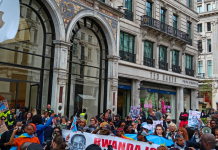Bettina Trabant argues that Trump’s disregard of climate change is yet another reason to oppose his presidency.

For several decades, we have known the threat to our climate caused by human activity. As many as 97% of published climate scientists say that global warming is real and man-made. A survey conducted by the Pew Research Center in 2015 concluded that 54% of participants in 40 nations believe it to be a very serious problem. According to Susan Joy Hassol of the Presidential Climate Action Project, in order to avoid runaway climate change, rising sea levels and temperature increases of up to 7°C, we need to curb CO2 emissions by 80% by 2050. Climate change is not a distant threat, but something that is already happening.
While there is broad consensus that climate change is real, it is sadly not matched by the urgent action that is needed. Politicians in most countries are torn between ‘going green’ and preserving the short- and medium-term economic interests of their countries and the capitalist class that they represent. While some leaders have tried to make moves towards integrating environmental policy and long-term economic plans, others appear willing to sacrifice all ‘green’ initiatives to please their capitalist class in the short term. President Donald Trump is firmly in the second camp.
President Obama’s legacy on climate change can be described as ‘complicated’. On one hand, he signed legislation relating to climate change, such as the American Clean Energy and Security Act, but on the other he also accelerated fracking. Fracking, a form of fossil fuel extraction that began in 1949, which consists of drilling deep into the earth before applying chemicals and water to the rock to release the gas inside, is responsible for contamination of groundwater, CO2 emissions and increased risks of cancer. These contradictions arise due to the clash between what Obama’s administration knew the environment needed, and America’s participation in a competitive world market. As the Middle East and other sources of oil become more politically unstable and oil reserves dry up, America seeks to become energy independent. Between 2005 and 2010 the shale-gas industry grew by 45% a year and increased its share in the overall gas production for the USA from 4% to 24%. There are estimates by the National Petroleum Council that hydraulic fracturing will eventually account for 70% of natural gas development. Oil imports are also down from 65% in 2005 to 52% in 2011.
Capitalism, an economic system that is based on growth and economic competition, will by its own nature face limitations when trying to solve the climate crisis from within. Nevertheless, most politicians at least pay lip service to climate change and pass agreements, however ineffective, such as the Kyoto Protocol of 1997 that dealt with reducing CO2 emissions. By contrast, Donald Trump, a former TV host and businessman, is an unrepentant climate change denier who tweeted in 2012: “The concept of global warming was created by and for the Chinese in order to make US manufacturing non-competitive.” Within less than a month in office, Trump has already gone to great lengths to attack progressive politics on climate change.
We only need to look to his cabinet to find that most of his members are either climate change deniers or have links to the fossil fuel industry. Michael Brune, executive director of the Sierra Club, compared his nominations to putting arsonists in charge of the fire department. The department of the Interior is being lead by Ryan Zinke, a Montana congressman that has consistently voted in favour of drilling on public land. The Department of Energy is headed by former Texas governor Rick Perry who said that global warming was unproven, and the Department of State is led by former chairman and CEO of Exxon Mobile, Rex Tillerson. The list goes on.
Moreover, Trump has already made some sweeping changes to environmental policy that set the tone for his term as President, and has clearly shown that he sides with the polluters. On the Tuesday after his inauguration, Trump instructed all staff at the environmental protection agency to delete any reference to climate change from the agency’s web site, although this order was reversed a day later. The act was symbolic but striking, a marker of his intentions. More substantively, the Environmental Protection Agency has been ordered to freeze all its grants and contracts for climate research, environmental justice and pollution prevention programs.
Furthermore, Trump is attacking vital research into climate science and wants to scrap NASA’s Earth sciences division, calling its work ‘politicised’. He is also making plans to scrap Obama’s Clean Power Plan, which arose out of years of scientific research and aims a shift away from coal-fired power plants.
The building of the Keystone Pipeline, another controversial project that was shelved under Obama, has been signed off by Donald Trump. Keystone is a planned 1,897km pipeline running from the oil sands of Alberta, Canada, to Steele City, Nebraska and on completion could carry 830,000 barrels of oil each day. The Canadian tar sands are one of the most CO2 intensive ways of producing oil and have lead to the pollution of the Attabasca River. On top of this, Trump is keen for America to opt out of the Paris agreement that asks signatories to take steps to reduce CO2 emissions to keep global temperature increases below 2°C. The agreement was drafted in 2015 and signed by 192 states.
There is hope, though. Since Trump came to power two weeks ago, we have seen mass protests in America and across the globe against his policies. Every time Trump announces a new policy or signs a controversial presidential decree, a demonstration gets called. London alone has had four mass mobilisations with several tens of thousands demonstrating against his racism, sexism, bigotry and stance on the environment. On the big women’s march on 21 January, I spoke to one woman from Surrey who had never been on a demonstration before and was agitated not just about Trump, but about the NHS and cuts in the UK too. Trump’s policies are so unpopular that he has the ability to politicise people and to mobilise far beyond habitual protesters.
There are more protests planned in the future. On 22 April, scientists are marching on Washington. In the meantime, rogue twitter accounts from both EPA and NASA employees have been set up in protest against Trump’s attempt to silence their voices. (@AltNatParkSer, @altUSEPA and @RogueNASA). An angry, young and diverse mass movement against Trump has already been born in America and across the globe, and if it continues to grow and accompany Trump’s every move, it has the ability to destabilise his presidency and turn into demands for more radical policies. Trump’s presidency could radicalise and politicise thousands of people and it is vital for the left to be involved to shape the discussion and introduce people to revolutionary politics.


















